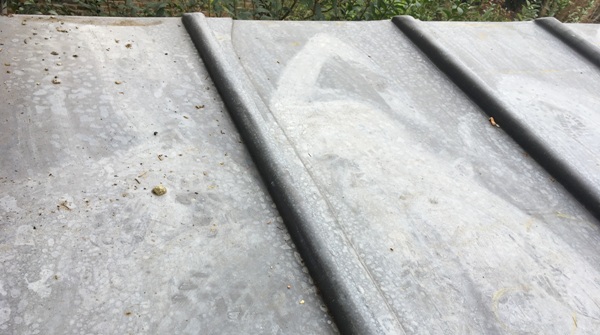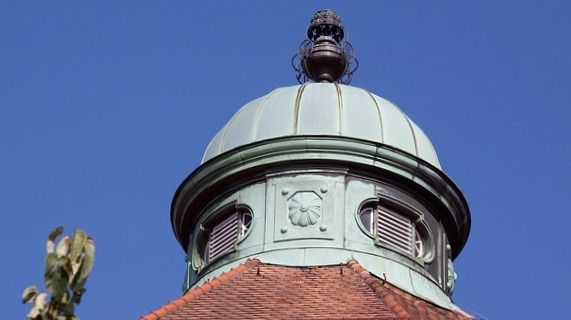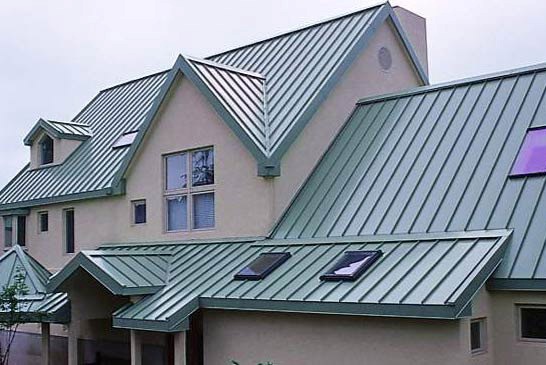Metal roofing
Contents |
[edit] Introduction
Metal can be used as a roof covering in several different ways. The main forms are based on sheet-like panels, which may be flat or profiled, and either prefabricated, or formed on site, but metal can also be used to create shingles - formed into shapes similar to tiles, shakes or slates.
Sheet metal roofing is typically joined by standing seams or rolled joints. These have no exposed mechanical fasteners, but use a clipped, or rolled design which creates a distinctive projecting seam. This is a very flexible system that can be pre-fabricated or formed on site, and used to create straight or curved seams.
A wide range of profiled and corrugated metal roof panels (sometimes referred to as 'wriggly tin') are also available, historically associated with industrial buildings, as well as built-up roofing systems and trims and flashings to form valleys, ridges, rooflights, aprons, sills, corners, barges and so on.
[edit] Types of metal
Metal roofing materials are primarily manufactured from aluminium and steel, as they are economical, relatively easy to work, are durable and able to receive a number of different finishes.
Steel is heavier than other metal options but as a result is sturdier and can be coated with a range of finishes to provide protection against rust and corrosion as well as to provide colour. Aluminium is more lightweight and is resistant to rust. However, it is more expensive, and relatively soft and so is more prone to denting and marring.
Other metals available for roofing tend to be more expensive, and include:
- Copper: Has been used over centuries for roofs, is rust-resistant, and weathers naturally.
- Alloy roofing products: Formulated from more than one metal to tailor properties of strength and durability.
- Stainless steel: Does not rust or corrode.
- Zinc: Malleable, versatile and resistant to corrosion.
- Lead: Heavy and relatively expensive, but malleable and durable. Can be cut and formed on site to complex shapes.

|

|
| Lead roof | Copper roof |
[edit] Advantages of metal roofs
The benefits of metal roofs can include:
- Life expectancy: Properly installed, a metal roof should have a long lifespan, being resistant to harsh weather, fire, mildew, infestation and rot.
- Weight: Metal roofing is generally lightweight compared with traditional tiles.
- Ease of installation: Most metal roofing materials come in sections,panels or rolls that are prefabricated off site and are relatively quick and easy to instal.
- Metal can reflect radiant heat from the sun, although it does become hot, and so, many systems include insulation, or a dead-air space between the metal and the interior.
- Minimal roof pitch: Most materials can be installed on gently pitching roofs without the danger of water penetration.
- Rain and snow shedding: Metal surfaces are hard and relatively 'slippery', meaning they tend to shed rain and snow relatively easily.
- Walkable: Most metals roofs can be walked on if necessary, although they may be slippery if wet.
[edit] Disadvantages of metal roofs
Disadvantages include the following:
- Cost: Metal roofing has a relatively high capital cost, although it can prove to be an economical investment due to its durability.
- Noise: Metal is noisier than some other materials when there is rain or hail falling on it. The drumming effect can be controlled by using materials that have structural barriers and the use of sound-deadening insulation.
- Denting: Metal can be prone to denting and scratching.
- Expansion and contraction: Metal expands and contracts as it warms and cools, which means that fastening systems must accommodate movement or else end up coming loose.
- Difficult to modify: As they are installed in large panels they can be more difficult to change.
- Theft: Some metals, such as lead have a high value, and are relatively easy to remove.
[edit] Related articles on Designing Buildings Wiki
- Aluminium.
- Cladding.
- Copper.
- Crinkly tin.
- Decorative metal ceilings.
- Domestic roofs.
- Failure of metals.
- Flashing.
- Galvanised steel.
- Lead.
- Long span roof.
- Major cast metal components.
- Metal.
- Metal composite panels.
- Metal profile cladding.
- Pitched roof.
- Roof coverings.
- Roof tiles.
- Shingle roofing.
- Structural steelwork.
- Types of cool roofs.
- Types of roof.
- Zinc
Featured articles and news
Latest Build UK Building Safety Regime explainer published
Key elements in one short, now updated document.
UKGBC launch the UK Climate Resilience Roadmap
First guidance of its kind on direct climate impacts for the built environment and how it can adapt.
CLC Health, Safety and Wellbeing Strategy 2025
Launched by the Minister for Industry to look at fatalities on site, improving mental health and other issues.
One of the most impressive Victorian architects. Book review.
Common Assessment Standard now with building safety
New CAS update now includes mandatory building safety questions.
RTPI leader to become new CIOB Chief Executive Officer
Dr Victoria Hills MRTPI, FICE to take over after Caroline Gumble’s departure.
Social and affordable housing, a long term plan for delivery
The “Delivering a Decade of Renewal for Social and Affordable Housing” strategy sets out future path.
A change to adoptive architecture
Effects of global weather warming on architectural detailing, material choice and human interaction.
The proposed publicly owned and backed subsidiary of Homes England, to facilitate new homes.
How big is the problem and what can we do to mitigate the effects?
Overheating guidance and tools for building designers
A number of cool guides to help with the heat.
The UK's Modern Industrial Strategy: A 10 year plan
Previous consultation criticism, current key elements and general support with some persisting reservations.
Building Safety Regulator reforms
New roles, new staff and a new fast track service pave the way for a single construction regulator.
Architectural Technologist CPDs and Communications
CIAT CPD… and how you can do it!
Cooling centres and cool spaces
Managing extreme heat in cities by directing the public to places for heat stress relief and water sources.
Winter gardens: A brief history and warm variations
Extending the season with glass in different forms and terms.
Restoring Great Yarmouth's Winter Gardens
Transforming one of the least sustainable constructions imaginable.
























Comments